Braided hairstyles adorned with colorful beads have been a cherished tradition in many cultures for generations, and today they’re experiencing a vibrant renaissance in children’s hairstyling.
If you’re searching for creative ways to style your child’s hair that combines practicality with playful expression, you’ve come to the right place.
This comprehensive guide explores 33 fun braided hairstyles for kids with beads, offering everything from simple everyday styles to elaborate designs perfect for special occasions.
Whether your child has thick, curly hair or fine, straight strands, these bead-adorned braids protect hair while allowing young ones to express their unique personality.
From classic cornrows enhanced with wooden beads to whimsical bubble braids featuring rainbow-colored accessories, each style in this collection has been carefully selected to be both beautiful and age-appropriate.
You’ll discover step-by-step guidance on creating these looks, tips for choosing the right beads, techniques for ensuring comfort and hair health, and creative ideas that will make your child excited about their next hairstyle.
Get ready to transform hair time from a chore into a creative bonding experience that produces stunning results your child will love to show off.
Contents
- 1 1. Classic Cornrow Braids with Wooden Beads
- 2 2. Rainbow Bead Box Braids
- 3 3. Side-Swept Braids with Pearl Beads
- 4 4. Zigzag Part Cornrows with Metallic Beads
- 5 5. Bubble Braids with Colorful Elastic Bands and Beads
- 6 6. Heart-Shaped Braid Pattern with Pink Beads
- 7 7. Twisted Crown Braid with Gold Accent Beads
- 8 8. Micro Braids with Scattered Colorful Beads
- 9 9. Lemonade Braids with Yellow Beads
- 10 10. Double Dutch Braids with Alternating Bead Colors
- 11 11. Halo Braid with Crystal Beads
- 12 12. Tribal-Inspired Geometric Braids with Natural Beads
- 13 13. Mohawk Braid with Colorful Beads
- 14 14. Criss-Cross Pattern Braids with Two-Tone Beads
- 15 15. Fishtail Braids with Pearlescent Beads
- 16 16. Bantu Knots with Bead Accents
- 17 17. Ladder Braids with Rainbow Beads
- 18 18. Feed-In Braids with Gradient Bead Colors
- 19 19. Diagonal Braids with Metallic Gold Beads
- 20 20. Half-Up Half-Down Braids with Mixed Beads
- 21 21. Starburst Pattern Braids with Neon Beads
- 22 22. Waterfall Braids with Clear Crystal Beads
- 23 23. Zig-Zag Side Braids with Contrasting Beads
- 24 24. Spiral Braids with Ombre Beads
- 25 25. Basket Weave Braids with Wooden Cube Beads
- 26 26. Asymmetrical Braids with Mixed Metallic Beads
- 27 27. Crown and Loose Braids with Flower-Shaped Beads
- 28 28. Fulani Braids with Mixed Beads and Cowrie Shells
- 29 29. Rope Twist Ponytail with Gradient Beads
- 30 30. Intricate Swirl Pattern Braids with Pearl Accents
- 31 31. Triangle Box Braids with Color-Blocked Beads
- 32 32. Side Cornrows with Alternating Size Beads
- 33 33. Mixed Braid Styles with Coordinated Beads
- 34 Hair Care Tips for Braided Styles with Beads
- 35 Choosing the Right Style for Your Child
- 36 Tutorial Resources and Learning
- 37 Cultural Appreciation and Respect
- 38 Cost Considerations and Budgeting
- 39 Common Challenges and Solutions
- 40 Seasonal Style Adaptations
- 41 Building Your Child’s Confidence Through Hairstyling
- 42 Conclusion
1. Classic Cornrow Braids with Wooden Beads

Cornrows are the foundation of protective styling for children, and adding wooden beads elevates this timeless look to something truly special.
This style works beautifully for school, playdates, or any everyday activity while keeping hair neat and manageable.
Why This Style Works:
- Cornrows lie flat against the scalp, reducing tangles and breakage throughout the day
- Wooden beads are lightweight and won’t cause tension on delicate hair follicles
- The natural aesthetic of wood complements all skin tones beautifully
- This style can last 2-3 weeks with proper nighttime care and maintenance
- Suitable for children ages 4 and up with various hair textures
Styling Instructions:
- Part the hair into even sections using a rat-tail comb for precision
- Apply a light moisturizing cream to each section before braiding
- Braid tightly enough to be secure but loose enough to avoid scalp tension
- Thread wooden beads onto the last inch of each braid
- Secure beads with small rubber bands or by knotting the braid end
2. Rainbow Bead Box Braids

Box braids with rainbow-colored beads create a festival of color that brings joy to any child’s appearance.
This protective style allows for maximum creativity while keeping hair healthy and growing strong.
Benefits of This Colorful Style:
- Box braids distribute weight evenly across the scalp, preventing stress on any single area
- Rainbow beads can be matched to favorite outfits or school colors
- The style promotes hair growth by minimizing daily manipulation
- Children can express their personality through bead color choices
- Easily maintained with regular scalp moisturizing between washes
Color Coordination Tips:
- Choose 3-5 main colors to avoid overwhelming the overall look
- Consider your child’s favorite colors or upcoming seasonal themes
- Alternate bead colors in patterns for visual interest
- Mix translucent and opaque beads for dimensional appeal
- Include some neutral beads to balance brighter colors
3. Side-Swept Braids with Pearl Beads

Elegant side-swept braids adorned with pearl beads offer a sophisticated look perfect for special occasions like weddings, recitals, or formal photographs.
This asymmetrical style combines grace with youthful charm.
Creating the Perfect Side Sweep:
- Begin by creating a deep side part that extends to the back of the head
- Braid the larger section into 4-6 medium-sized braids
- Sweep all braids to one shoulder for the signature asymmetrical look
- Thread pearl beads at intervals along the braid length for elegance
- Secure the style with decorative bobby pins if needed for extra hold
4. Zigzag Part Cornrows with Metallic Beads

Zigzag parting adds geometric interest to traditional cornrows, while metallic beads provide a modern, edgy accent that kids find exciting.
This style showcases precision and creativity in equal measure.
The Zigzag Advantage:
- The zigzag pattern makes the style look more complex and impressive
- Metallic beads catch the light beautifully, adding dimension to the hairstyle
- This parting technique distributes tension differently than straight parts
- The style stands out in photographs and special events
- Works well for children who want something unique but structured
Creating Zigzag Parts:
- Use the pointed end of a rat-tail comb to create the pattern
- Mark your zigzag path lightly before committing to the part
- Keep the peaks and valleys of your zigzag consistent in size
- Section one area at a time to maintain pattern clarity
- Practice the pattern a few times before adding beads
5. Bubble Braids with Colorful Elastic Bands and Beads

Bubble braids create a fun, three-dimensional effect that children absolutely adore, and adding beads between each bubble section amplifies the playful aesthetic.
This style is perfect for active kids who need secure hair that looks fantastic.
Why Kids Love Bubble Braids:
- The puffy bubble sections create a whimsical, cartoon-like appearance
- Beads add weight that makes the bubbles more pronounced and defined
- This style is relatively quick to create compared to traditional braiding
- Works exceptionally well for medium to long hair lengths
- Easy to customize the bubble size based on hair length
Step-by-Step Bubble Creation:
- Create one or multiple ponytails as the base for your bubbles
- Place elastic bands at 2-3 inch intervals down the length of the ponytail
- Gently pull and tease the hair between elastics to create bubble volume
- Thread 2-3 beads onto the hair between bubbles for accent
- Secure the end with a final elastic and optional bead cluster
6. Heart-Shaped Braid Pattern with Pink Beads

Nothing says “sweet” quite like heart-shaped braid patterns accented with pink beads, making this style perfect for Valentine’s Day, birthday parties, or any day your child wants to feel extra special.
Creating the Heart Pattern:
- Map out your heart shape on the scalp before beginning to braid
- Start at the top center point and work down each side of the heart
- Use smaller braids to create the curved heart shape more easily
- Place beads along the heart outline to emphasize the shape
- Fill the interior of the heart with straight or curved cornrows
7. Twisted Crown Braid with Gold Accent Beads
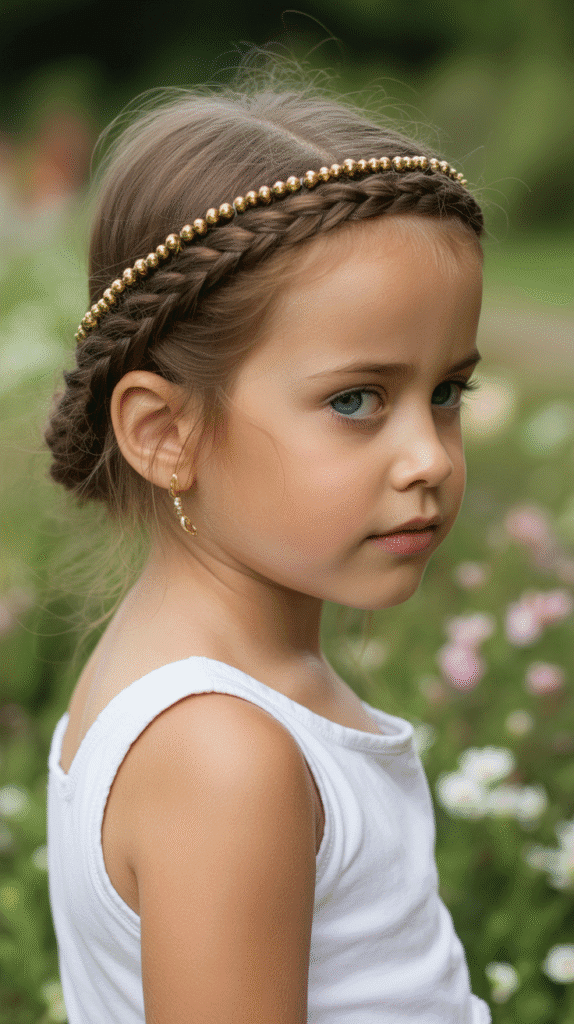
A crown braid creates a regal appearance that makes any child feel like royalty, and gold accent beads enhance this majestic look with just the right amount of shimmer.
The Regal Crown Approach:
- Begin braiding at one ear and work around the head’s circumference
- Braid closely to the hairline to create the crown frame
- Space gold beads evenly along the braid for balanced elegance
- Tuck the braid end securely underneath the style for a seamless finish
- Add small flowers or ribbons alongside beads for extra special occasions
8. Micro Braids with Scattered Colorful Beads
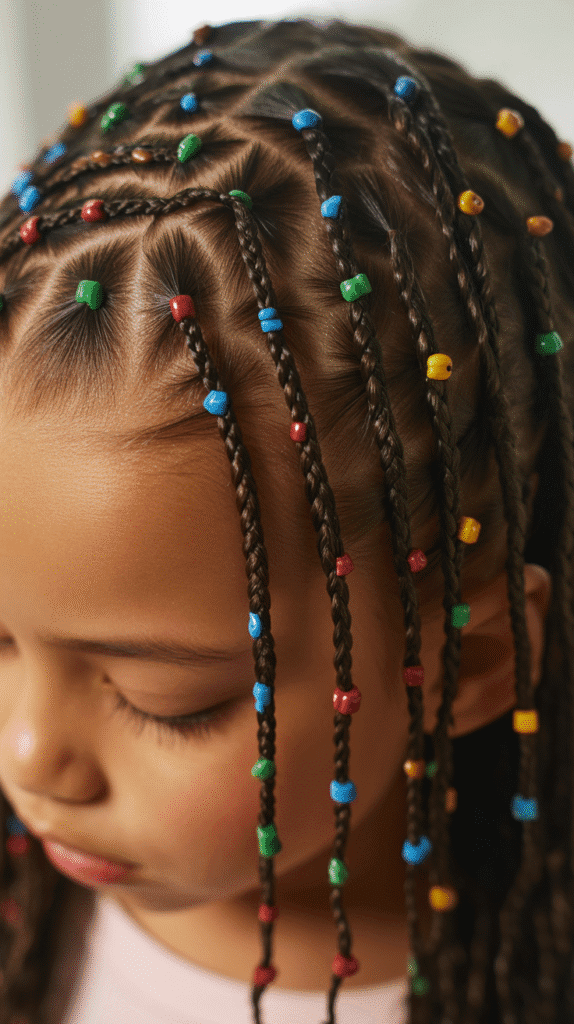
Micro braids require patience but deliver stunning results that can last for weeks, and scattered colorful beads throughout add pops of surprise and delight to this intricate style.
Micro Braid Mastery:
- Micro braids are best suited for children who can sit patiently during styling
- These thin braids minimize weight and tension on the scalp
- Scatter beads randomly rather than placing them systematically for a natural look
- This style offers maximum versatility for different updos and ponytails
- Expect 4-6 hours of braiding time depending on hair thickness and length
Maintenance Tips:
- Moisturize the scalp every 2-3 days with a light oil spray
- Sleep with a silk or satin bonnet to preserve the style
- Avoid excessive manipulation to extend the style’s longevity
- Cleanse the scalp with diluted shampoo and a cotton ball if needed
- Plan to keep micro braids in for 4-6 weeks maximum
9. Lemonade Braids with Yellow Beads

Inspired by Beyoncé’s iconic look, lemonade braids sweep dramatically to one side and when accented with yellow beads, create a sunny, confident style that empowers young girls.
The Lemonade Signature:
- All braids angle toward one side rather than going straight back
- The diagonal direction creates visual movement and modern edge
- Yellow beads enhance the “lemonade” theme with citrus-inspired color
- This style works for various hair lengths from shoulder to waist
- Perfect for children who want to emulate their favorite performers
10. Double Dutch Braids with Alternating Bead Colors

Double Dutch braids offer a sporty, practical style that keeps hair completely secured, and alternating bead colors down each braid adds visual rhythm and personality.
Athletic Style Advantages:
- Dutch braids (reverse French braids) create a raised, 3D effect on the head
- The secure braiding keeps hair in place during sports and physical activities
- Alternating bead colors in patterns teaches children about sequencing and design
- This style is relatively quick to create, taking only 20-30 minutes
- Works beautifully for school, sports practice, and casual weekend activities
Pattern Ideas:
- Alternate two colors in a simple repeating pattern (red, blue, red, blue)
- Create an ombre effect by gradually transitioning from light to dark beads
- Use team colors for young athletes to show school spirit
- Try metallic and matte beads for textural contrast
- Space beads 1-2 inches apart for balanced visual weight
11. Halo Braid with Crystal Beads

The halo braid wraps around the head like an angelic crown, and crystal beads add sparkle that catches the light beautifully, perfect for flower girls or special celebrations.
Creating Sparkle Magic:
- The halo braid combines elegance with complete hair containment
- Crystal beads reflect light from multiple angles for maximum sparkle
- This style keeps hair away from the face while looking sophisticated
- Works best with shoulder-length or longer hair for full circumference
- Consider adding baby’s breath or small flowers alongside crystal beads
12. Tribal-Inspired Geometric Braids with Natural Beads
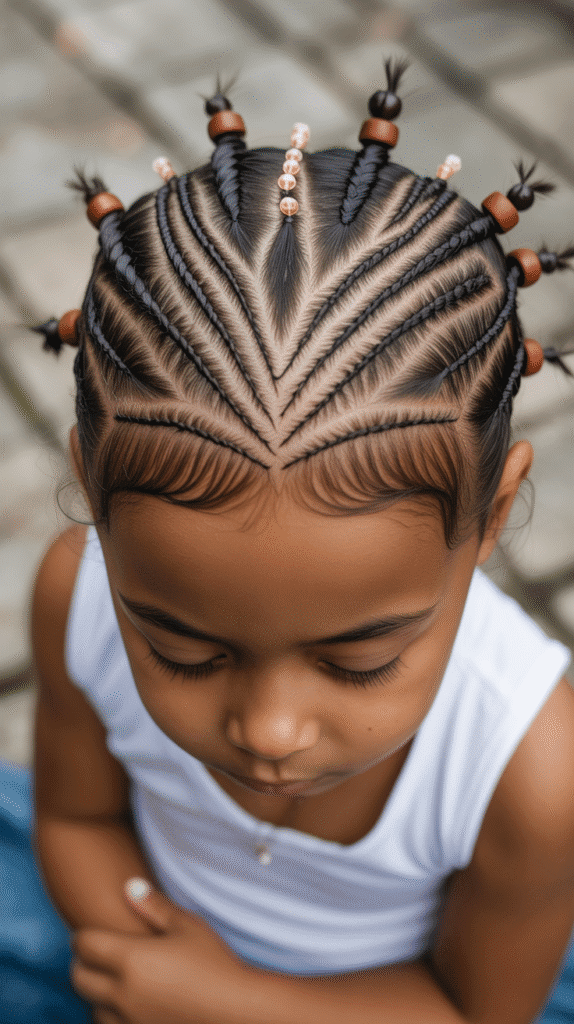
Geometric braid patterns honor traditional African hairstyling techniques, and natural wooden or clay beads pay homage to cultural roots while creating striking visual designs.
Cultural Connection:
- Geometric patterns have deep roots in African hairstyling traditions
- Natural materials like wood, clay, and bone create authentic cultural connections
- These patterns can be customized to represent family heritage or personal meaning
- The precision required develops patience and respect for traditional craftsmanship
- Educational opportunity to discuss cultural significance with children
Popular Geometric Patterns:
- Triangle sections radiating from the crown
- Diamond patterns across the scalp
- Circular designs centered on the crown area
- Asymmetrical patterns for modern interpretation
- Combination patterns that blend multiple geometric shapes
13. Mohawk Braid with Colorful Beads
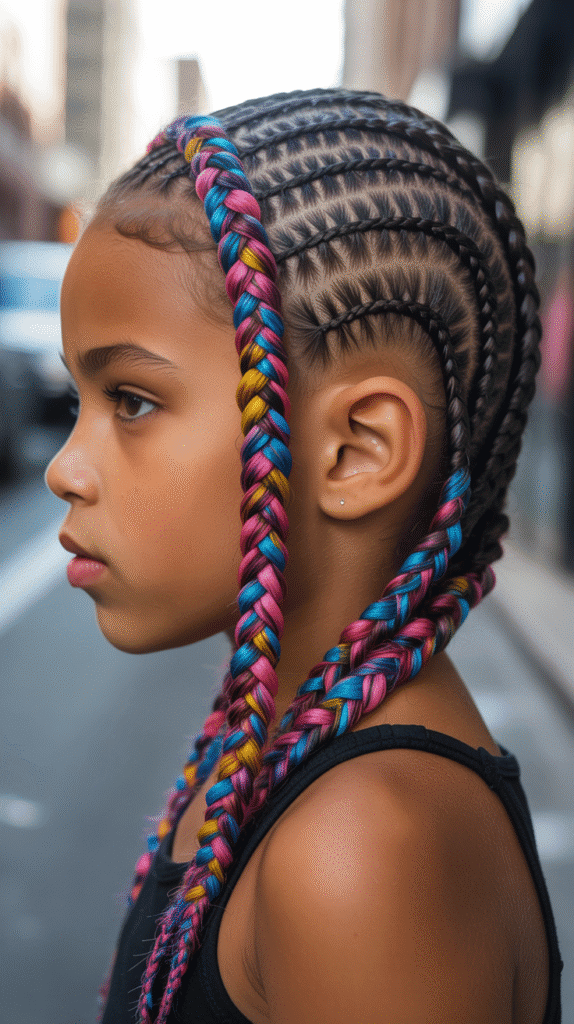
The mohawk braid creates bold statement styling that confident kids love, with a braided center section running from forehead to nape and sides styled smoothly, all enhanced with vibrant beads.
Bold and Beautiful:
- The center braid can be made as wide or narrow as desired
- Side sections can be cornrowed, twisted, or left braided in tiny braids
- Colorful beads along the mohawk emphasize its height and centrality
- This edgy style appeals to children with bold personalities
- Surprisingly practical for keeping hair neat despite its dramatic appearance
14. Criss-Cross Pattern Braids with Two-Tone Beads
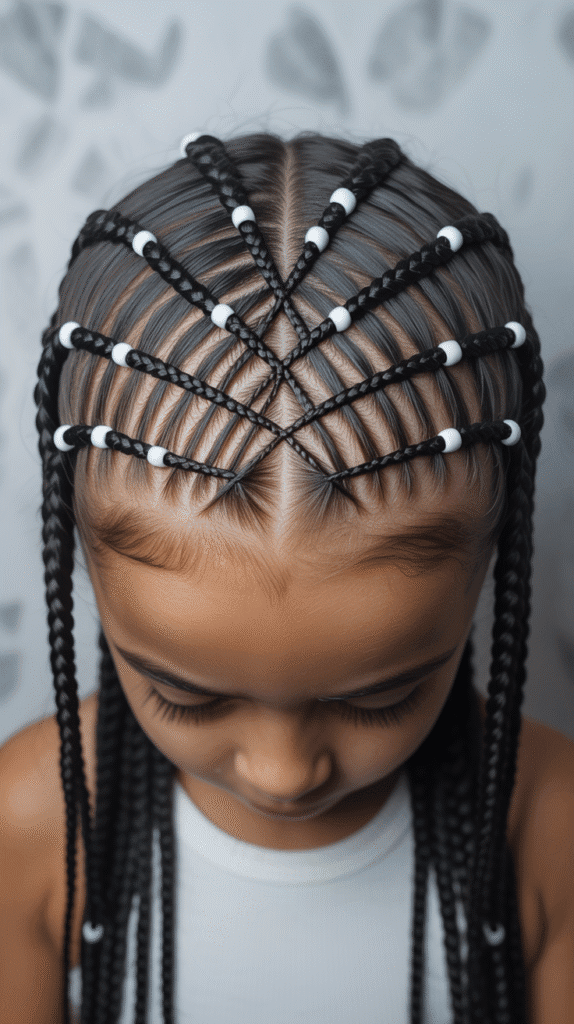
Criss-cross braids create an intricate woven appearance across the scalp, and two-tone beads emphasize the intersections where braids cross, highlighting the pattern’s complexity.
The Intersection Effect:
- Criss-cross patterns require advanced braiding skills but deliver impressive results
- Two-tone beads at intersections draw the eye to the pattern’s architecture
- This style works best for special occasions due to its time-intensive creation
- The woven effect creates depth and dimension
- Excellent choice for children who want to stand out at events
15. Fishtail Braids with Pearlescent Beads
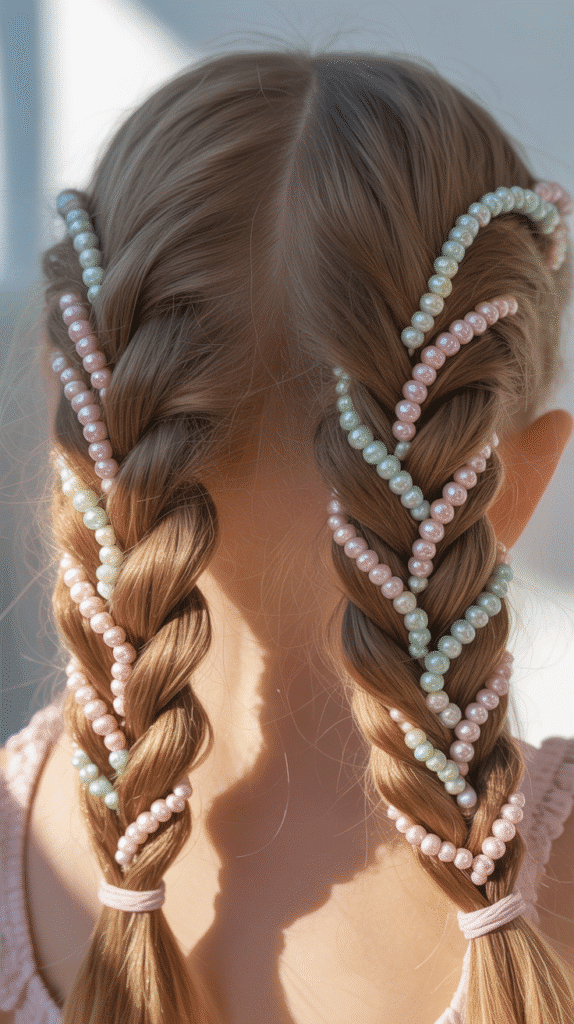
Fishtail braids offer a unique texture that differs from traditional three-strand braids, and pearlescent beads add an iridescent quality that shifts color in different lighting.
Fishtail Texture Appeal:
- The four-strand weaving technique creates a distinctive herringbone pattern
- Fishtail braids appear more intricate than they actually are to create
- Pearlescent beads complement the braid’s sophisticated texture
- This style works for both casual and dressy occasions
- Best suited for fine to medium hair textures
16. Bantu Knots with Bead Accents
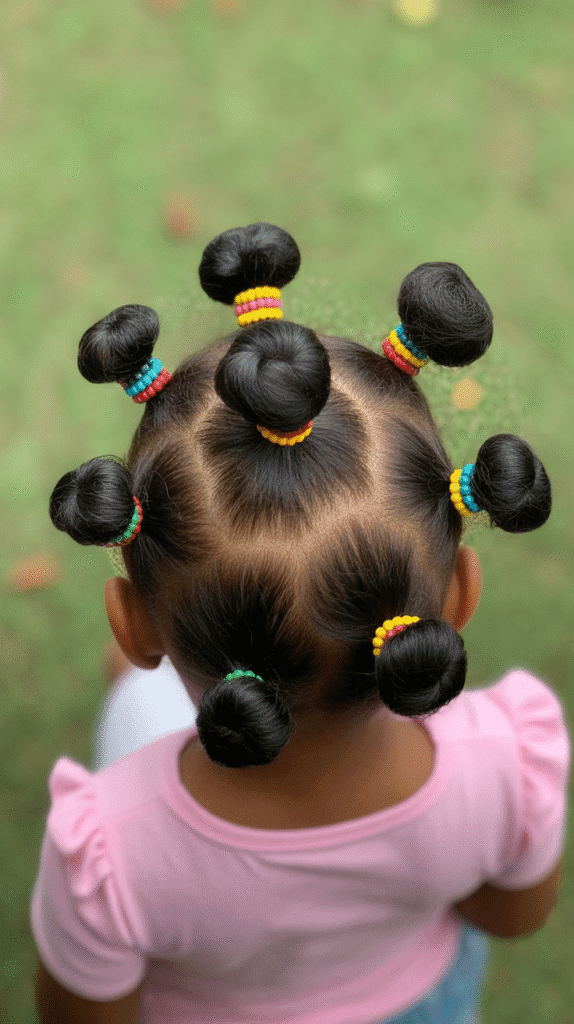
Bantu knots create sculptural sections across the scalp, and adding beads at the base of each knot provides colorful punctuation to this textured protective style.
Knot Styling Benefits:
- Bantu knots protect hair while creating beautiful definition
- When unraveled, knots create gorgeous curls and waves
- Beads at the knot base add decorative interest without weighing down the style
- This versatile style can last several days before being taken down
- Minimal tension makes it comfortable for children to wear
17. Ladder Braids with Rainbow Beads

Ladder braids create a unique vertical effect with horizontal sections connecting vertical braids, resembling a ladder, and rainbow beads on the horizontal sections create eye-catching color breaks.
The Ladder Technique:
- Vertical braids run from hairline to nape as the ladder’s sides
- Horizontal braids connect the vertical sections at regular intervals
- Rainbow beads on horizontal sections create the ladder “rungs”
- This style requires intermediate braiding skills and planning
- The finished look impresses at competitions and special events
18. Feed-In Braids with Gradient Bead Colors

Feed-in braids start small at the hairline and gradually increase in thickness, creating a natural-looking style, and gradient bead colors that transition from light to dark enhance this flowing effect.
The Feed-In Advantage:
- Feed-in technique reduces tension on the hairline compared to traditional cornrows
- The gradual thickness increase looks more natural and less harsh
- Gradient beads echo the braid’s increasing thickness with color progression
- This healthier braiding method prevents traction alopecia
- Suitable for children with tender scalps or fine hairlines
Creating Gradient Effects:
- Choose 3-5 bead colors that transition smoothly from one to another
- Start with the lightest color near the scalp
- Gradually introduce darker shades as you move down the braid
- Blend colors by occasionally mixing adjacent shades
- Complete the gradient with the darkest color at braid ends
19. Diagonal Braids with Metallic Gold Beads
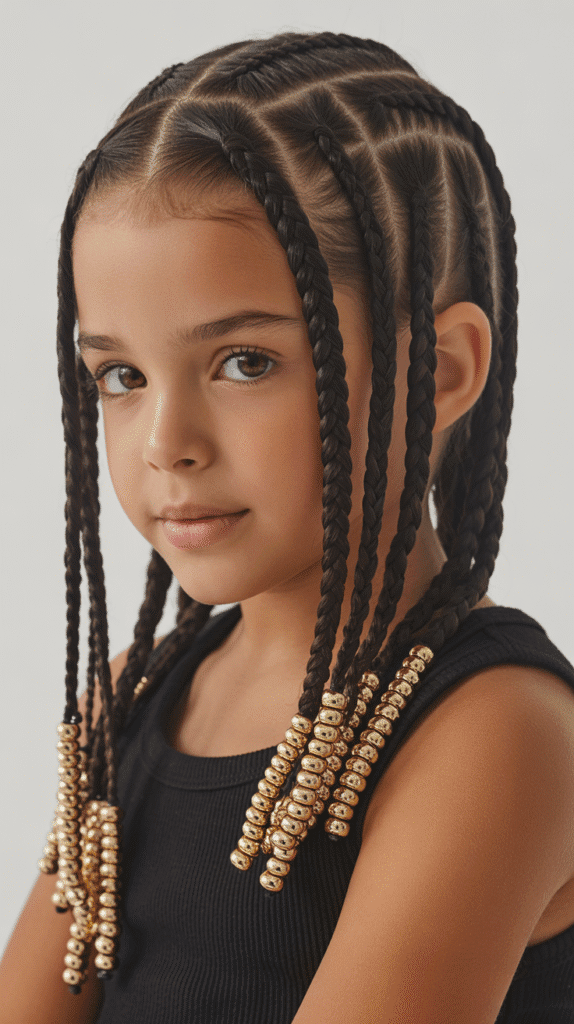
Diagonal braids slant across the head from one side to the other, creating dynamic visual movement, and metallic gold beads add luxurious accents that elevate the style’s sophistication.
Diagonal Direction Benefits:
- The angled direction adds visual interest and contemporary style
- All braids flowing in the same diagonal creates cohesive movement
- Gold beads catch light from multiple angles as the head turns
- This style flatters various face shapes with its directional flow
- Quick to install compared to more complex pattern work
20. Half-Up Half-Down Braids with Mixed Beads

This versatile style combines braided and loose hair sections, with the top braided portion adorned with mixed beads while the bottom half flows freely or is styled in loose curls.
Versatility of Half-Up Styles:
- Combines the security of braids with the freedom of loose hair
- Mixed bead colors in the top section add playful detail
- The loose bottom half can be curled, straightened, or left natural
- Perfect for children transitioning from all-braided to more varied styles
- Works beautifully for both everyday wear and special occasions
21. Starburst Pattern Braids with Neon Beads

The starburst pattern radiates braids outward from a central point on the crown, creating a dramatic sunburst effect, and neon beads amplify the energetic, radiating aesthetic.
Creating Starburst Impact:
- Mark the center point on the crown before beginning any braiding
- Braid outward from the center in evenly spaced sections
- Neon beads emphasize each radiating line for maximum impact
- This style makes a bold statement at birthday parties and special events
- The pattern can be adjusted to create more or fewer rays
22. Waterfall Braids with Clear Crystal Beads

Waterfall braids create the illusion of hair cascading through the braid like a waterfall, and clear crystal beads enhance this flowing effect with sparkle that mimics water droplets.
The Waterfall Effect:
- Sections of hair are dropped and picked up as you braid, creating the cascade
- Crystal beads attached to dropped sections enhance the waterfall illusion
- This romantic style works best for special occasions and photographs
- Requires practice but creates a stunning visual effect
- Best suited for longer hair lengths to show the full cascade
23. Zig-Zag Side Braids with Contrasting Beads

Side-swept braids with zig-zag parting create visual texture before the braids even begin, and contrasting colored beads provide bold color blocking that makes the style pop.
Contrast and Clarity:
- Zig-zag parts add immediate visual interest to the style
- Contrasting bead colors (black and white, dark and light) create bold definition
- The side-swept direction keeps braids manageable and visible
- This style photographs exceptionally well with its strong contrast
- Appeals to children who like graphic, high-impact aesthetics
24. Spiral Braids with Ombre Beads

Spiral or twist braids create rope-like texture, and ombre beads that graduate from one color family to another complement the twisting motion with flowing color transitions.
Spiral Styling:
- Two-strand twists create the spiral effect more easily than three-strand braids
- Ombre beads should transition gradually over the braid length
- The twisting direction can be clockwise or counterclockwise
- This style is gentler on hair than tight braiding
- Perfect for creating definition without excessive tension
25. Basket Weave Braids with Wooden Cube Beads

Basket weave patterns create dimensional sections that overlap like woven baskets, and wooden cube beads add geometric accents that complement the woven aesthetic.
Woven Complexity:
- Basket weave requires advanced planning and execution
- The over-under pattern creates raised dimensional effects
- Wooden cube beads add geometric counterpoint to organic braiding
- This style demonstrates exceptional braiding skill
- Best reserved for very special occasions due to time investment
26. Asymmetrical Braids with Mixed Metallic Beads
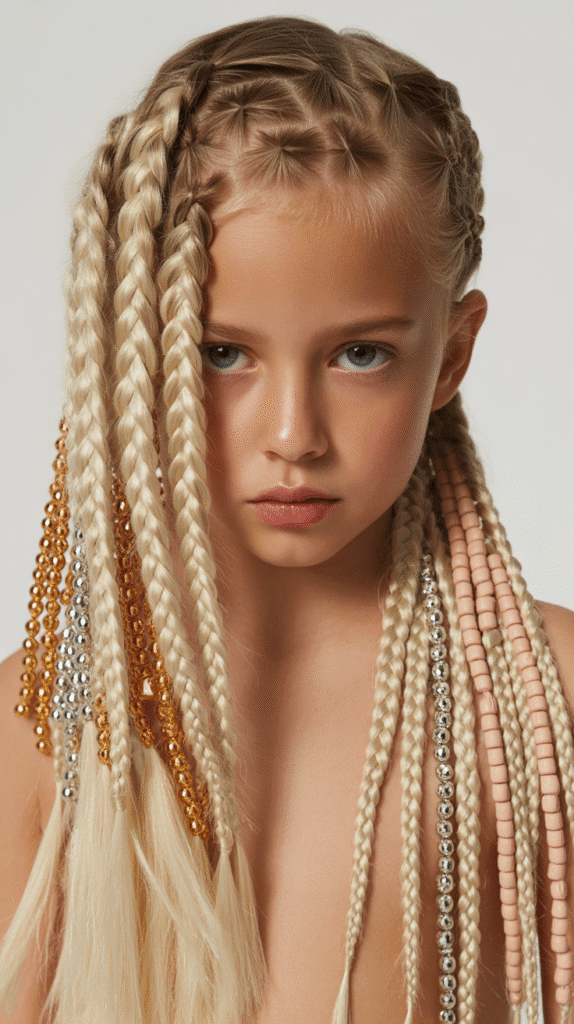
Asymmetrical designs place different numbers or sizes of braids on each side of the head, creating intentional imbalance, and mixed metallic beads (gold, silver, copper) add eclectic sophistication.
Embracing Asymmetry:
- One side might have one large braid while the other has multiple smaller ones
- The intentional imbalance creates contemporary edge
- Mixed metallics prevent the style from looking too matchy or predictable
- Appeals to children with artistic or non-conformist personalities
- Encourages creative expression through hairstyling
27. Crown and Loose Braids with Flower-Shaped Beads
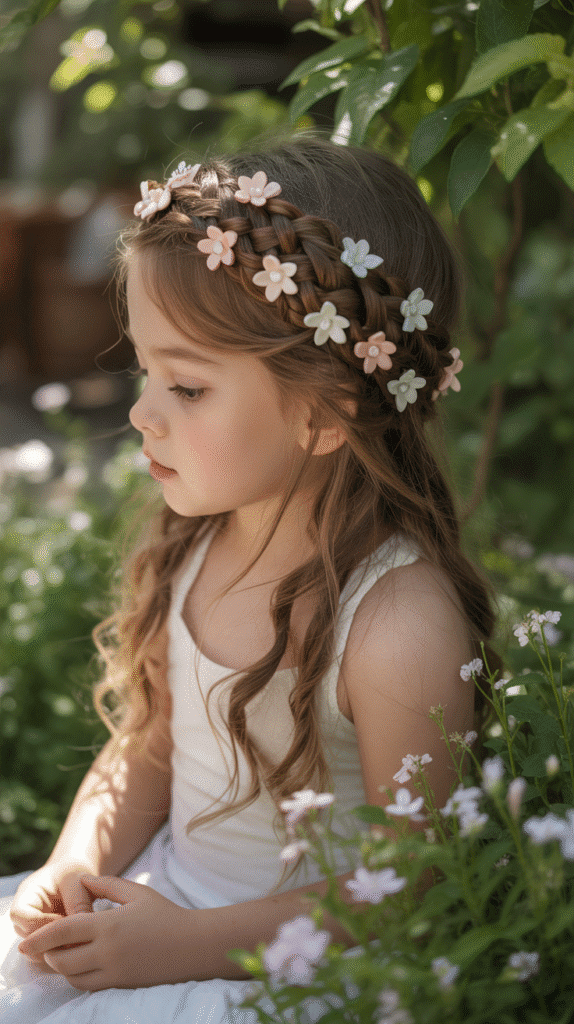
A braided crown around the hairline frames the face while the remaining hair is braided into loose sections, all accented with flower-shaped beads for a garden-fresh aesthetic.
Garden Romance:
- The crown braid frames the face beautifully
- Flower-shaped beads reinforce the natural, garden-inspired theme
- Loose back braids provide movement and softness
- Perfect for spring and summer occasions
- Works well for flower girls, garden parties, and nature photography
28. Fulani Braids with Mixed Beads and Cowrie Shells
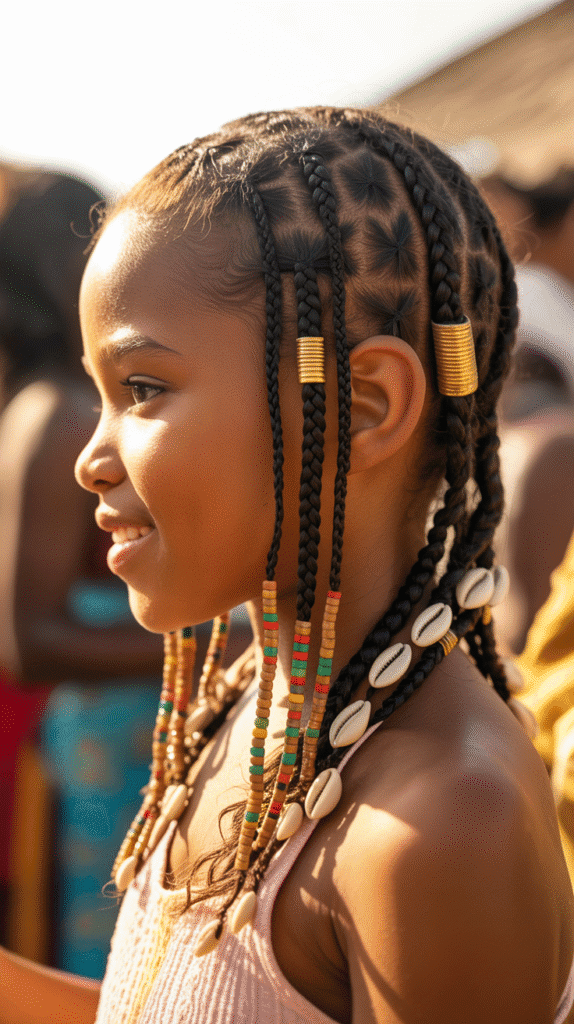
Fulani braids feature distinctive center braids with beads, side cornrows, and decorative elements like cowrie shells, honoring West African heritage with authentic styling.
Cultural Heritage Style:
- Fulani braids have specific characteristics that honor the Fulani people
- Central braids are typically adorned with beads and sometimes gold rings
- Cowrie shells carry cultural significance and add authentic detail
- Side braids often wrap around the head or hang as accents
- This style celebrates cultural identity and traditional beauty
Traditional Elements:
- Thin center braids running front to back
- Beads threaded to hang from central braids
- Side cornrows or twists framing the face
- Cowrie shells as traditional decorative elements
- Optional gold cuffs or rings for added authenticity
29. Rope Twist Ponytail with Gradient Beads

Multiple rope twists gathered into a high ponytail create texture and height, and gradient beads transitioning from light to dark down the ponytail add dimensional color interest.
Ponytail Power:
- Rope twists create more texture than standard ponytails
- The high placement adds youthful energy and bounce
- Gradient beads guide the eye down the ponytail length
- This style keeps hair completely off the face and neck
- Perfect for sports, dance, or hot weather activities
30. Intricate Swirl Pattern Braids with Pearl Accents

Swirl patterns create curved, flowing designs across the scalp, and pearl beads placed along the swirls emphasize the graceful curves for an elegant, artistic result.
Artistic Swirls:
- Curved patterns require flexible braiding technique
- Swirls can spiral inward, outward, or create S-curves
- Pearl beads follow the curves like jewelry on display
- This style transforms hair into wearable art
- Best suited for special events where appearance is paramount
31. Triangle Box Braids with Color-Blocked Beads

Box braids parted in triangular sections rather than squares create geometric interest, and color-blocked beads (all beads on one braid are the same color) create organized visual impact.
Geometric Organization:
- Triangle parting adds visual variety to traditional box braids
- Color-blocking by braid creates organized, intentional appearance
- Each color represents a different personality trait or mood
- Children can choose their own color assignments for each braid
- The systematic approach appeals to organized, detail-oriented kids
32. Side Cornrows with Alternating Size Beads
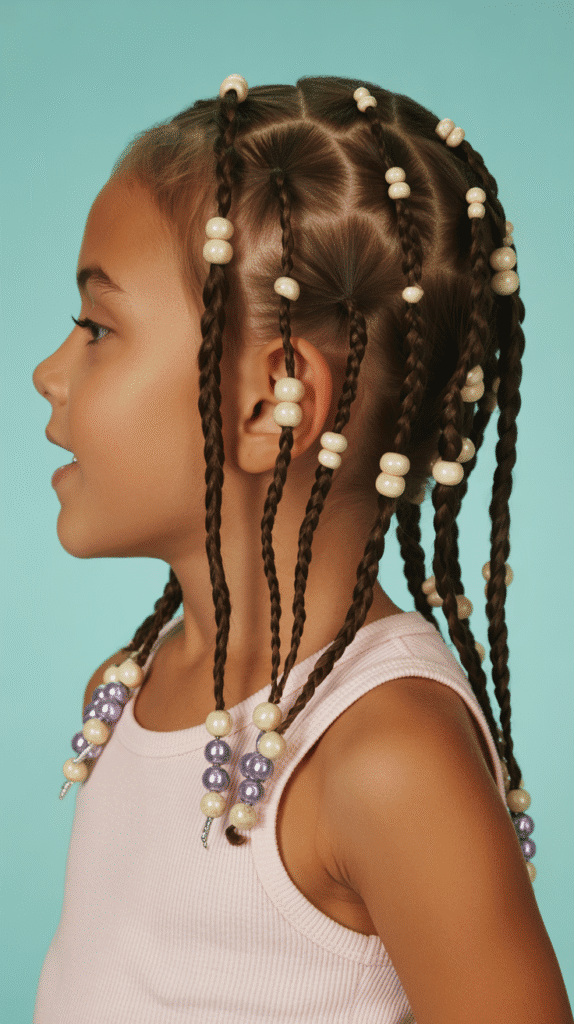
Multiple cornrows running along one side of the head create a side-swept effect, and alternating between large and small beads creates rhythmic visual interest down each braid.
Size Variation Benefits:
- Alternating bead sizes creates visual rhythm and movement
- The side direction makes bead patterns highly visible
- Different sizes add dimension and tactile interest
- Children enjoy the varied texture of different bead sizes
- This technique works with any color palette
33. Mixed Braid Styles with Coordinated Beads

Combining multiple braiding techniques—cornrows, box braids, twists—in one style showcases versatility, and coordinating all beads within a single color family unifies the diverse elements.
Ultimate Versatility:
- Mixing techniques demonstrates advanced styling ability
- Different sections serve different aesthetic and practical purposes
- Coordinated bead colors prevent the style from looking chaotic
- This approach allows customization to the child’s hair type and preferences
- Perfect for children who want truly unique, personalized styles
Coordination Strategies:
- Choose one color family for all beads (blues, pinks, neutrals)
- Use different bead types (wood, plastic, metal) in the same color
- Place larger beads on thicker braids and smaller on finer sections
- Consider the overall balance and symmetry of bead placement
- Step back frequently during creation to assess visual harmony
Hair Care Tips for Braided Styles with Beads
Maintaining healthy hair while wearing braids and beads requires attention to proper care techniques.
Understanding these essential practices ensures your child’s braided style remains beautiful while keeping their hair and scalp healthy throughout the style’s duration.
Daily Maintenance:
- Apply light oil or moisturizer to the scalp every 2-3 days to prevent dryness
- Focus on the scalp rather than the braids themselves when moisturizing
- Use a spray bottle with diluted leave-in conditioner for easy application
- Gently massage the scalp with fingertips to stimulate circulation
- Check bead security daily and replace any loose rubber bands immediately
Nighttime Protection:
- Always cover braided hair with a silk or satin bonnet before sleeping
- Alternatively, sleep on a silk or satin pillowcase to reduce friction
- Loose-fitting bonnets prevent pressure on bead-heavy braids
- Never go to sleep with wet or damp braided hair
- Consider wrapping longer braids to prevent tangling during sleep
Cleansing Strategies:
- Dilute shampoo with water in a spray bottle for targeted scalp cleansing
- Focus on the scalp and roots rather than the braid lengths
- Use a cotton ball or pad soaked in diluted shampoo to clean between braids
- Rinse thoroughly to prevent product buildup
- Limit washing to once per week or every two weeks depending on activity level
When to Take Braids Down:
- Most braided styles should not be kept longer than 6-8 weeks
- Remove braids earlier if significant frizz or loosening occurs
- Watch for signs of tension or discomfort on the scalp
- If edges appear stressed or thinning, remove braids immediately
- Schedule a one-week break between major braiding sessions
Avoiding Common Problems:
- Never braid wet hair as this can cause mildew and breakage
- Ensure braids are snug but not tight to prevent tension alopecia
- Don’t add beads that are too heavy for the braid thickness
- Avoid styles that pull excessively on the hairline or edges
- Remove any beads that cause discomfort or catch on clothing
Choosing the Right Style for Your Child
Selecting the perfect braided hairstyle with beads involves considering multiple factors beyond just visual appeal.
Understanding your child’s unique needs, lifestyle, and hair characteristics ensures the chosen style will be both beautiful and practical for their daily activities.
Age-Appropriate Considerations:
- Younger children (3-5 years) benefit from simpler styles with larger, lightweight beads that won’t overwhelm their delicate scalp
- School-age children (6-10 years) can handle more intricate patterns and longer sitting times for complex styles
- Preteens (11-13 years) often prefer trendy, fashion-forward styles that express their developing personal identity
- Consider your child’s patience level and ability to sit still during the styling process
- Match style complexity to the child’s comfort with hair maintenance routines
Hair Texture and Length Guidelines:
- Tightly coiled hair (Type 4) holds braids exceptionally well and suits most protective styles
- Wavy to curly hair (Type 2-3) may require additional products for braid security
- Fine hair needs looser braiding tension to prevent breakage and scalp stress
- Thick, dense hair can support heavier bead arrangements without strain
- Shoulder-length hair offers the most versatility for various braid styles
- Shorter hair works best with cornrows, Bantu knots, or styles close to the scalp
Lifestyle and Activity Matching:
- Athletes need secure styles like cornrows or feed-in braids that withstand vigorous movement
- Dancers benefit from updos or pulled-back styles that won’t obstruct movement or vision
- Children who swim regularly should choose styles that dry quickly and resist water damage
- Academic-focused children might prefer neat, conservative styles appropriate for school environments
- Artistic children often enjoy expressive, creative styles with bold color choices
Occasion-Based Selection:
- School/Everyday: Classic cornrows, box braids, simple ponytails with minimal bead adornment
- Sports Events: Secure cornrows, feed-in braids, styles that keep all hair contained
- Special Occasions: Elaborate patterns, crown braids, styles with special bead arrangements
- Seasonal Considerations: Lighter styles with fewer beads for summer heat, fuller styles for cooler months
- Cultural Celebrations: Traditional styles like Fulani braids that honor heritage
Comfort and Health Priority:
- Never sacrifice comfort for aesthetics when selecting a braided style
- Test a few braids first to ensure your child tolerates the tension level
- Avoid styles that cause headaches, scalp tenderness, or sleep disruption
- Choose bead weights appropriate to hair strength and thickness
- Schedule adequate breaks between intensive braiding sessions
- Listen to your child’s feedback about what feels comfortable
Tutorial Resources and Learning
For parents and caregivers interested in learning these braiding techniques, numerous quality resources provide step-by-step guidance.
Building your braiding skills allows you to create these beautiful styles at home while bonding with your child.
Recommended Learning Approaches:
- Search for video tutorials on platforms like YouTube using specific style names
- Practice basic three-strand braiding before attempting more complex patterns
- Start with simple cornrows and gradually progress to intricate designs
- Consider taking a braiding class at local beauty schools or community centers
- Connect with experienced braiders in your community for mentorship
- Join online forums and social media groups dedicated to natural hair care
Essential Tools and Products:
- Rat-tail comb for precise parting and sectioning
- Wide-tooth comb for gentle detangling before braiding
- Edge control or styling gel for smooth, neat braids
- Moisturizing cream or hair butter for pre-braid preparation
- Light oil (jojoba, coconut, or specialized hair oils) for scalp health
- Small rubber bands for securing braid ends under beads
- Bead threader or large needle for threading beads onto braids
- Spray bottle with water for keeping hair damp during styling
- Satin/silk bonnet for nighttime protection
- Clips for sectioning hair during the braiding process
Time Management Tips:
- Allocate sufficient time based on style complexity (2-6 hours for most styles)
- Break longer sessions into multiple days to prevent child fatigue
- Provide entertainment like movies, audiobooks, or games during styling
- Take regular breaks for snacks, bathroom visits, and stretching
- Work during your child’s most patient time of day
- Have all supplies prepared and organized before beginning
Cultural Appreciation and Respect
When exploring braided hairstyles with beads, understanding the cultural significance behind many of these styles enriches the experience and ensures respectful appreciation rather than appropriation.
Understanding Cultural Context:
- Many braiding techniques originated in African cultures with deep historical roots
- Braiding served as cultural identity markers, social status indicators, and artistic expression
- Cornrows have been worn in Africa for thousands of years and carry significant heritage
- Fulani braids specifically honor the Fulani people of West Africa
- Beads and cowrie shells often held spiritual or symbolic meanings in traditional contexts
- Hairstyles communicated information about age, marital status, wealth, and tribal affiliation
Respectful Practice:
- Acknowledge the cultural origins when discussing or showcasing these styles
- Support Black-owned hair care businesses and braid artists
- Educate children about the history and significance of the styles they wear
- Avoid claiming these styles as modern inventions or personal creations
- Respect that for many people, these styles connect to identity and heritage
- Listen to voices from the cultures these styles originate from
Teaching Moments:
- Use hairstyling sessions as opportunities to discuss cultural diversity
- Share age-appropriate stories about the history of various braid styles
- Explore books and resources about African hair traditions with your child
- Visit museums or cultural centers that showcase traditional hair practices
- Encourage appreciation for the skill and artistry involved in these techniques
- Help children understand the difference between appreciation and appropriation
Cost Considerations and Budgeting
Understanding the financial aspects of braided hairstyles helps families plan appropriately and make informed decisions about professional styling versus at-home creation.
Professional Salon Pricing:
- Simple cornrows with beads: $50-$100 depending on location and complexity
- Box braids with beads: $100-$300 based on length, thickness, and bead quantity
- Intricate pattern work: $150-$400 for elaborate designs requiring advanced skills
- Children’s styles typically cost 20-30% less than adult versions
- Urban areas generally have higher pricing than suburban or rural locations
- Experienced specialists may charge premium rates for exceptional work
At-Home Cost Benefits:
- Initial tool investment: $30-$50 for essential combs, clips, and products
- Bead collections: $10-$40 depending on quality, quantity, and material
- Hair products: $20-$40 for moisturizers, oils, and styling products lasting multiple styles
- Time investment replaces financial cost when creating styles at home
- Total at-home cost per style: approximately $5-$15 after initial setup
- Skills improve with practice, increasing value of at-home styling over time
Budget-Friendly Strategies:
- Purchase beads in bulk from craft stores for significant savings
- Start with simpler styles that require less time and expertise
- Invest in quality tools that will last for years of use
- Use multi-purpose hair products suitable for various styling needs
- Trade styling services with friends or family who have braiding skills
- Look for beauty school students who offer discounted services for practice
- Watch for sales on hair care products and bead supplies
Common Challenges and Solutions
Even experienced braiders encounter challenges when creating styles with beads.
Understanding common issues and their solutions helps ensure successful, beautiful results.
Challenge: Beads Sliding Off Braids
Solutions:
- Secure braid ends with small, clear rubber bands before adding beads
- Tie a small knot at the braid end underneath the bottom bead
- Choose beads with smaller holes that fit more snugly on braids
- Add a tiny amount of edge control at the braid tip before threading beads
- Double up rubber bands for extra security on slippery hair types
Challenge: Braids Too Tight Causing Discomfort
Solutions:
- Constantly check tension by asking your child about comfort during braiding
- Leave slightly looser braids near the hairline where skin is most sensitive
- If tightness causes pain, carefully remove and re-braid affected sections immediately
- Apply warm compress to tender areas after completing the style
- Use feed-in technique instead of traditional braiding to reduce tension
Challenge: Uneven Braid Sizes
Solutions:
- Section hair precisely using a rat-tail comb and measuring technique
- Create a clear parting pattern before beginning any braiding
- Take consistent amounts of hair for each braid section
- Practice makes perfect—expect improvement with each styling session
- Use clips to hold sections and maintain organization during braiding
Challenge: Beads Too Heavy for Hair
Solutions:
- Choose lightweight plastic or wooden beads instead of heavy metal
- Reduce the number of beads per braid for children with fine hair
- Place beads only on thicker, stronger braids rather than all braids
- Avoid placing multiple large beads consecutively without spacing
- Monitor your child’s comfort and remove beads if complaints arise
Challenge: Frizz and Flyaways
Solutions:
- Apply edge control or gel during the braiding process for smoothness
- Braid hair when slightly damp for easier control
- Use a soft bristle brush to smooth sections before braiding
- Tie a silk scarf over completed style for 10-15 minutes to set braids
- Accept that some texture and natural appearance is healthy and beautiful
Seasonal Style Adaptations
Different seasons call for different considerations when choosing braided hairstyles with beads.
Adapting styles to weather conditions ensures comfort and style longevity.
Summer Styling:
- Choose styles that keep hair completely off the neck and shoulders for cooling
- Opt for updos, high ponytails, or styles that maximize airflow to the scalp
- Use lighter, fewer beads to reduce weight during hot weather
- Select moisture-resistant products that won’t melt or become sticky in heat
- Cornrows and feed-in braids work exceptionally well for swimming activities
- Rinse hair with fresh water after pool or ocean swimming to remove chemicals and salt
Fall and Winter Adaptations:
- Fuller styles with more beads provide extra warmth during cooler months
- Protect braids from winter dryness with regular oil treatments
- Cover braided styles with silk-lined winter hats to prevent frizz and breakage
- Moisturize more frequently as indoor heating creates dryness
- Avoid letting braids freeze when wet by ensuring complete drying before going outside
- Choose richer, heavier moisturizers suitable for cold weather hair needs
Spring Refresh:
- Lighter, flowery styles with pastel beads celebrate the season’s freshness
- Spring break provides ideal timing for installing new styles without school pressure
- Incorporate floral beads or flower accessories for seasonal appeal
- Refresh winter styles with new bead colors in spring tones
- Take advantage of moderate temperatures for longer styling sessions
Holiday Styling:
- Coordinate bead colors with holiday themes (red and green for Christmas, pastels for Easter)
- Plan elaborate styles ahead of major holiday celebrations
- Metallic beads add festive sparkle for New Year’s and special events
- Cultural holiday celebrations may call for traditional styling approaches
- Allow extra time before holidays for style creation to avoid last-minute stress
Building Your Child’s Confidence Through Hairstyling
Beyond the practical and aesthetic benefits, braided hairstyles with beads offer powerful opportunities to build self-esteem and confidence in children.
Empowerment Through Choice:
- Allow children to participate in style selection for ownership of their appearance
- Let them choose bead colors that express their personality and preferences
- Respect their feedback about comfort and style likes or dislikes
- Encourage creative input about patterns, designs, and combinations
- Celebrate their unique beauty through personalized styling choices
Positive Affirmations During Styling:
- Use styling time for positive conversations about beauty, uniqueness, and self-worth
- Compliment your child’s patience, creativity, and personal style
- Share stories about family members and cultural connections to hair traditions
- Discuss how different is beautiful and everyone’s hair has unique qualities
- Create a relaxed, positive atmosphere during what could be lengthy styling sessions
Handling Social Responses:
- Prepare children for potential questions or comments from peers about their hairstyles
- Equip them with simple, confident responses about their style choices
- Teach them to handle both compliments and criticism gracefully
- Address any negative comments immediately with support and perspective
- Celebrate and photograph completed styles to reinforce pride in their appearance
Documentation and Celebration:
- Take photos of each completed style to create a hair journey portfolio
- Share images with family members to spread joy and receive compliments
- Create a hairstyle journal where children can rate and remember favorite styles
- Celebrate styling milestones like first complex braid or new technique mastered
- Display photos where children can see them and feel proud of their appearance
Conclusion
Throughout this comprehensive guide to 33 fun braided hairstyles for kids with beads, we’ve explored a diverse collection of styles ranging from classic cornrows to intricate geometric patterns, each offering unique beauty and practical benefits.
These hairstyles represent more than just aesthetic choices—they embody cultural heritage, creative expression, protective hair care, and opportunities for parent-child bonding.
Whether you choose simple everyday styles with wooden beads for school mornings or elaborate designs with crystal accents for special celebrations, each braided look provides your child with a sense of individuality and confidence.
The versatility of braided hairstyles with beads means there’s a perfect option for every hair type, length, occasion, and personality.
By understanding proper techniques, maintenance requirements, cultural significance, and safety considerations, you can create stunning styles that keep your child’s hair healthy while celebrating their unique beauty.
Remember that practice develops skill, patience creates beautiful results, and every hairstyle becomes a memory of time spent together.
As you embark on your journey through these 33 fun braided hairstyles for kids with beads, approach each style with creativity, respect for tradition, and joy in the process of helping your child look and feel their absolute best.
